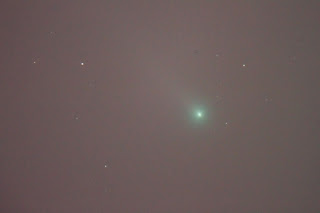Before I continue, I want to say there is a chance I'll try to image this comet again before the sun rises. If I can get equipment issues ironed out and the weather cooperates I may get a better photo this morning. One of the problems of course is the comet is getting brighter as it gets closer to the sun but the sky will glow from natural sky glow from the sunrise and images after 6am when the comet is higher are practically worthless as they start picking up a lot of blue sky and the contrast with the tail, renders the images pretty useless. We have to take all our images before 6am between 5 and 6am and the comet is fairly low on the horizon making it difficult to image from the observatory due to the wall obstruction. We need an object about 18 degrees above the horizon for the C14 to be able to image it. The Meade can image a little lower because it's mounted higher on top of the C14 and it can peek out of the shutter at a lower angle in the east and west.
A more detailed log about viewing the comet Tuesday follows:
Opened up but experienced a few issues and problems. ISON was not defined as a comet in the sky catalog and I had to download an updated comet list off the internet. I had some tracking/balancing issues and the auto-guiding camera would not connect. Some of these were possibly user error, others were perhaps related to my not being awake enough and having enough time to configure the observatory.
At first I looked at the comet visually through the C14 with a 40mm eyepiece. Temperatures were very cold out, about 27 degrees and there was a slight wind of about 10mph at the observatory.
The comet looked about as good as Panstarrs looked earlier in the year with a much smaller telescope. The C14 didn't seem to bring out much of the tail and I decided after looking for a short time to try to take some long exposure photos. I didn't get ideal images, because of tracking issues and the lack of time. I was running late, but no visitors showed up, so I was able to get a few photos.
This images are not anywhere as good as images taken by other astronomers of the comet. With better luck and more setup and planning time, I might be able to do better. As the comet gets closer to the sun it will be brighter. There's a chance Wednesday morning will be clear out and I may try to image the comet early this Wednesday and see if I can do better.
While looking at the comet through the C14 I tried to take a half a dozen exposures of the comet through the wide field Meade telescope. I took these with a Canon EOS T1i DSLR camera. I took relatively short exposures with the Meade as I was in a hurry to move the camera to the C14.
Here are five photos I took with the Meade 80mm refractor and the Canon DSLR. These were stacked with Deep Sky stacker and I worked on trying to tease out detail from 5 13 second exposures. We are talking about a total exposure time of only about a minute, so these images don't show the tail and faint parts of the comet as well as I'd like to see them.
I ended up playing with the image in Preview on the Macintosh and used way to much adjustments actually trashing the image pretty good, to get detail from the tail, but this introduced many noisy and oversaturated artifacts that make the comet look more like a comic book comet than a nice astrophotograph. I guess I can call it "art" and leave it there.
Below you can see the output from Deep Sky Stacker with some natural adjustments.
Deep Sky Stacker is a free program on the P.C. and it does a nice job of removing the motion in the five images and correcting the comet image. But we don't have a lot of detail to play with in the photo above.
The over saturated "artsy" kind of look. from a cropped image from the Meade adjusted to give more detail in the coma and tail. This makes it look a little bit more comic book like, which is not the normal goal of astronomers when taking images of deep sky objects.
- Moving to the C14
I was unable to get long exposures like a 180 second exposure or some exposure that might take five minutes. Something long which would bring out the tail of the comet would be nice. I saw some tracking or balancing errors with a 180 second exposure, so I made the decision to try to take a half a dozen 60 second exposures of the comet on the C14 and see if I could stack them to get a good image. Most of the 60 second exposures were not very good.
I ended up working on a single image from the C14 which was a 60 second exposure. A little bit of manipulation showed the following from Photoshop.
This image was manipulated further to try to enhance the detail in the tail but these are over-processed and introduces the same kind of artificial noise we see in the "art" like photo results from the Meade above.
I'm hoping to get better photos soon. Ison will be approaching the sun by the 28th of November and this is the week we'd want to get an image of it before glow from the moon would affect morning imaging.





No comments:
Post a Comment